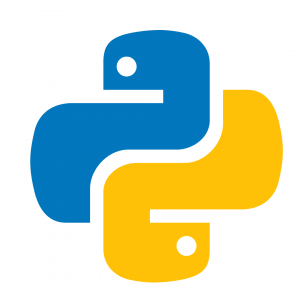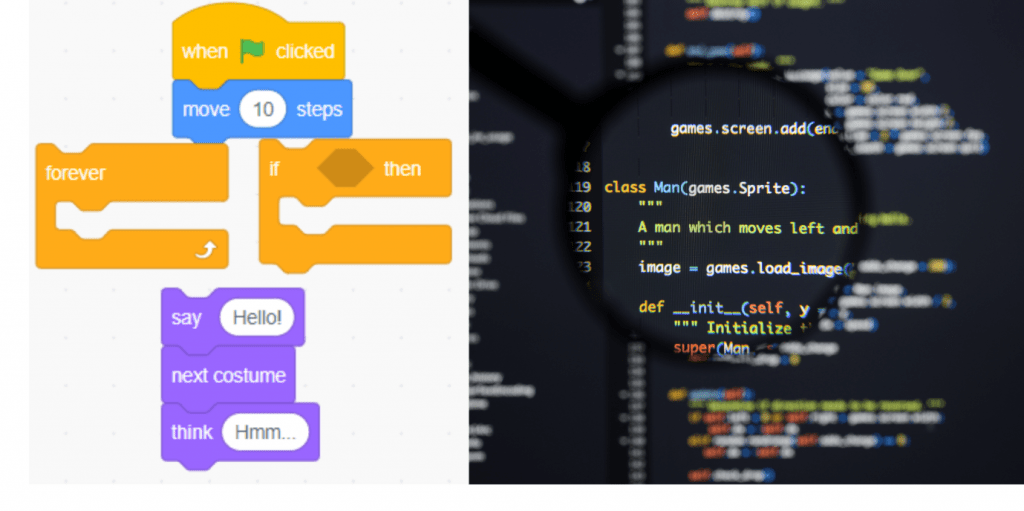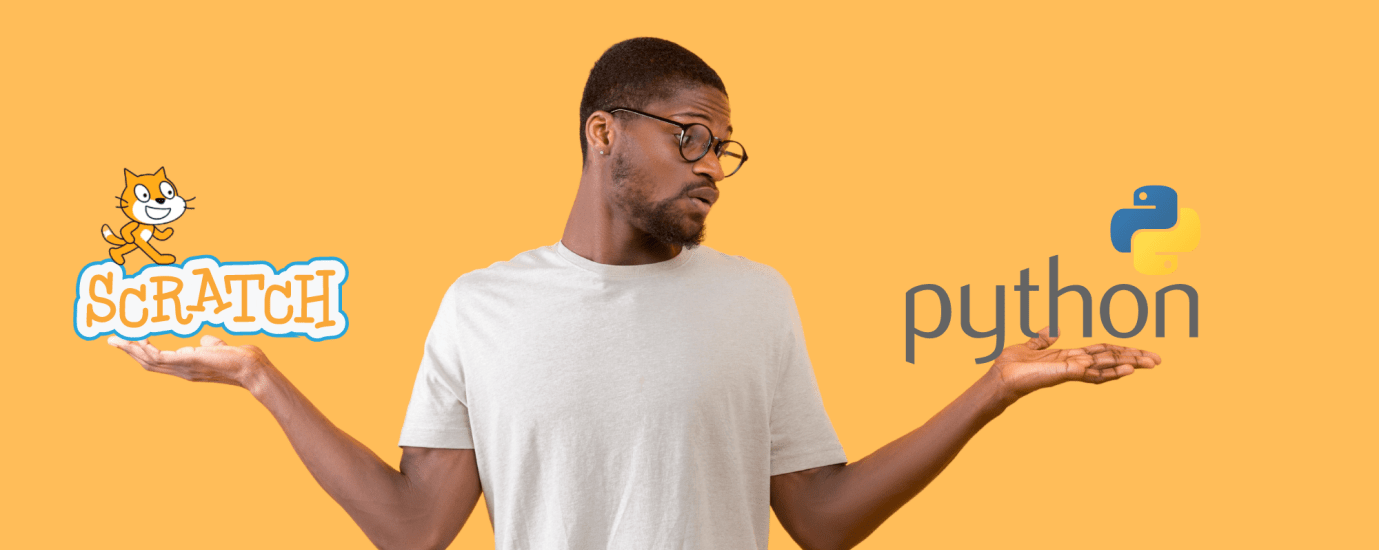Learning to code is a lot like embarking on a trip that is full of new experiences and opportunities to think beyond the box. Put your energy on gaining encouraging early encounters so that you may carry that momentum with you throughout the trip.
The fact that coding is one of the most comprehensive disciplines available may often leave children and the adults who are raising them unsure of how or where to begin learning the skill. Scratch and Python are two of the easiest programming languages to learn and use, which contributes to their eventual rise to the position of most popular programming language on the market.
These two languages are a great place for beginners to start learning how to code since they provide you a solid foundation in the fundamentals of what computer programming is all about.
The topic of which one to begin with is a frequent one for parents of children who are interested in coding for kids or learning to code and have asked their parents for advice on the subject. It is essential to keep in mind that the decisions might be influenced by the aspirations and passions of the youngster.
Before settling on a choice, it is important to take into account the skills and passions of your kid. For instance, do they like an interactive programming language that provides assistance in visually representing the code? Do they take pleasure in resolving issues using logic or mathematical puzzles? Or would they rather concentrate on the development of games? Which of these two options should you choose then? Continue reading to find out!
For Kids, Pick the Best Coding Apps
A parent must take into consideration a variety of factors that would teach their child the most. The child’s age, degree of technical comprehension and flexibility to problem-solving are the factors that are most crucial to consider. Children may learn the fundamentals of coding via the use of games, but advancing in programming languages requires a lot of reasoning, trial-and-error learning, and searching the internet for solutions to difficulties.
It’s also been suggested that having a mathematical background is necessary to code, however, this isn’t totally accurate. The ability to think mathematically is essential for programmers, since they must be able to comprehend various algorithms and functions that are specific to the language, they are working in. On the other hand, the majority of coding jobs need little more than a basic understanding of mathematics.
So, with that out of the way, let’s talk about the key distinctions and similarities between two Scratch and Python.
An Overview of Scratch

Scratch, created by Mitch Resnick and patented by the MIT Lifelong Kindergarten Group, is a free and easy programming language for children (MIT). It is one of the most widely used block-based programming languages, making it ideal for teaching children and beginners how to code.
Scratch is a programming environment that gives kids the ability to create their own animations, games, and interactive tales. It’s a great tool for getting kids interested in learning to code because of its bright colors, clear labeling, and likable characters.
An Overview of Python

Like Java, Python is an approachable language for new programmers. Even though Ruby was formerly the most popular programming language, Python has been ahead of it for a while now due to its superior clarity and directness.
In spite of Python’s reputation as a more complex language than Scratch, it is possible to teach it to kids. To simplify things and concentrate on what really matters, BlockyPy is a block-based version of Python with a drag-and-drop interface akin to Scratch. BlockPy, on the other hand, isn’t nearly as gamified as Scratch.
Python, when learned to an advanced degree, is a fantastic resource for creating serious games, websites, and apps, and is also a fantastic foundation for learning other programming languages.
How do they differ in Programming Environment?
Scratch is a block-based language that is better suited to younger students and those with less experience in programming. Scratch is a beginner’s programming environment.

Python, on the other hand, is a text-based programming language, and provides an enticing start to coding for secondary students.
Python is a more advanced programming language than Scratch. The process of learning Python may be difficult. On the other hand, Scratch is an excellent way for anyone with little or no prior expertise in programming to get their feet wet. Children may learn to code using Scratch by dragging and dropping “blocks” of logic into the canvas.
Applications and the possibility for projects
It is vital that you initiate project-based learning for your children at an early age. Kids may learn any language via project-based learning, but before you get your kids involved in it, you should be sure to question them about the kinds of things that interest them.
Kids have the opportunity to create amazing works of art and games with Scratch. Kids are able to design their own character for games by using Scratch. Kinaesthetic learners may utilize Scratch to engage with VEX robots and have a hands-on approach to grow better at their hobbies. Scratch is available for free on Microsoft Windows, macOS, and Linux.
Learning how to use Python for projects may take you in a variety of directions, and the possibilities are almost unlimited. Python is considered to be one of the most adaptable programming languages due to the fact that it is used at both the intermediate and expert levels of coding.
To mention just a few of its many uses, Python may be used in the creation of video games, artificial intelligence, machine learning, and cryptography. One of the reasons why the technology organizations such as Google, Facebook, Amazon, and Uber, among others, employ Python.
Python would be the best option for your kid to use if they have already mastered the principles of programming, have a solid understanding of how programming works, and want to step up their game in coding since there is so much more they can learn and grow in the process. To know more about Python, you can read the blog 5-reasons-why-python-programming-is-best-for-kids.
Time Required for the Project
The amount of effort that children need to put into learning each language in order to get the desired outcomes is quite different.
Python is a somewhat lengthy programming language, and using it may sometimes add several weeks or even months to the time it takes to finish a project. Python might be a good starting point for your children to learn if they have an analytical mind and like games that need them to solve logic puzzles.
Scratch is a good option for beginners for children who are more interested in a more visual approach and an interactive user interface. The process of Scratch is completed in a single moment. As soon as you make a move, the outcomes of your action will immediately appear on the screen for you to view. Scratch also comes with a variety of engaging and interactive features that your children may use to maintain their interest in the program.
So far we have seen how different the two systems are, let’s look at some of the commonalities between Scratch and Python.
When programming languages are made to be user-friendly for beginners, the process of teaching coding to children is simplified, and both of these languages are fantastic for teaching coding to beginners.
While the goal of the highly interactive, block-based programming environment known as scratch is to familiarize children with the many fundamentals of computer programming,
Python, on the other hand, is geared for young people who excel in finding solutions to issues, such as developing new technologies, and who are interested in pursuing successful careers in the field of technology.
Valuable Online Resources Available
Learners of both Python and Scratch have access to a wealth of materials that may help them improve their skills.
Scratch provides a wide variety of how-to guides and other instructional materials, all of which may be accessed and used without cost. There is a wealth of instructional material pertaining to Python that can be discovered on websites such as Udemy and Codecademy.
Consequently, regardless of whether your children are interested in beginning with visual-based computer programming or interesting text-based coding, they may have access to a variety of online assistance options that will assist them in improving their skills and becoming more capable.
Big community of programmers working together
There is a big community of developers working on Scratch and Python all around the world; in fact, there are literally hundreds of thousands of developers that contribute to and support a wide variety of open-source projects. During the process of building any project, you or your kid may visit a number of different blogs and forums.
Which Language Ought to Be Learned First by Your Child?
The age of your children, as well as their level of interest, should guide your choice of which language to teach them. Scratch may be a useful stepping stone for your children’s development if they are still in the early stages of that development. At SkoolofCode, the coding classes for kids begin at age of 6 with Scratch.
Python, on the other hand, is a good option to go with if your children have reached an older age and already have some experience working with computers.
Conclusion
When comparing Scratch vs Python, it is important to note that both of these programming languages are beginner-friendly and simple to pick up. Additionally, they are both quite powerful.
The benefits of education and training Scratch for the little ones
A language that makes learning programming ideas fun and fascinating, while also contributing to the development of foundational programming skills and logical reasoning Simple to pick up, and it can be accessed on a variety of devices. Students get the opportunity to study animation and build video games with the use of hardware extensions.
The benefits of teaching Python to children
Language for advanced programming that is simple to pick up and has codes that are easily understandable by other programmers. Utilized by enormous technology organizations like as Google, Amazon, Facebook, and others. There are a multitude of classes and guides available. The creation of artificial intelligence (AI), machine learning, app development, web development, advanced computing, and other fields all make use of one of the most popular and in-demand programming languages utilized today.
At SkoolofCode, we suggest using Scratch as a beginning platform for students in grades 1-2 at the very least. I have encountered many people who do not fit into the categories that I have described above; however, if I were to make a recommendation for the majority of the population, I would suggest that they begin with Scratch. This is because Scratch is a lot of fun, it teaches great principles, and in the end, we want our children to have a positive experience with coding rather than worrying about it from a young age.
Making the switch from Scratch to Python
Depending on the children’s skill levels, we usually move them from Scratch to Python about the time they are in the sixth or seventh grade. Your children will have access to a vast amount of potential using Scratch and Python, which might motivate them to continue their education.
Once kids begin learning any of these languages, they will have boundless options available to them, along with constant encouragement and support from others who are also learning the language.
We receive a lot of inquiries about the pros and cons of utilizing Scratch as opposed to jumping right into Python. Our coding classes for kids consist of an age-appropriate curriculum designed by the subject experts. If you are interested in teaching your children how to code, sign up for a free trial of the program now!
Get in contact with our staff if you have any questions regarding the coding lessons that we provide.
By – Ms. Manpreet Virk, Head of E-learning and an educator at SkoolofCode with degree in M.Phil. and Master in Computer Science. She is passionate about learning and teaching young minds.



